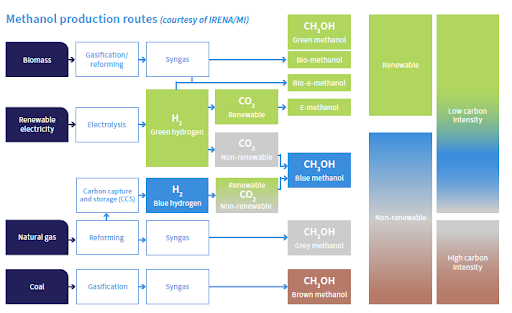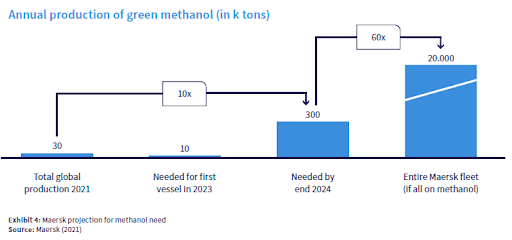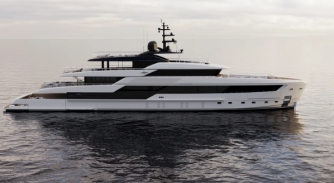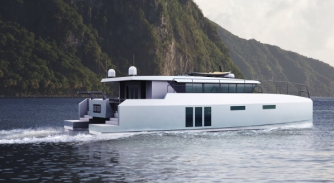Methanol's colour coding conundrum
Methanol is fast becoming a popular, environmentally friendly alternative fuel, but it is important to understand that not all methanol is created equal…
Methanol is a synthetic fuel that is rapidly gaining prominence as an alternative energy source in the superyacht industry. This is primarily due to its relatively straightforward storage and reduced harmful emissions, making it an appealing solution for those aiming to lessen their operational environmental impact.
This is evident in the superyacht industry, where there is an uptake in projects utilising methanol energy generation. This is especially exemplified by the recent Lloyd's Register approval for Sanlorenzo's 50steel methanol system and Feadship’s Dunes concept, this is in addition to other industry commitments, such as the collaboration between Lürssen and mtu Rolls Royce on upcoming methanol powered projects.
Methanol can be synthesised through a chemical reaction involving a carbon dioxide molecule and three hydrogen molecules, resulting in methanol and water. The energy for this production can be provided from various sources, primarily natural gas at this stage. However, with the increasing demand for so-called 'green methanol', its production methods have become more versatile. Many projects are now embracing renewable feedstocks, such as agricultural waste, Municipal Solid Waste (MSW), sewage, renewable electricity, and captured CO2.
However, it's worth noting that not all methanol is created equal, and its environmental credentials are heavily dependent on the production method employed. The numerous potential variations in methanol production can affect its negative environmental impact. This is where the concept of different "colours" of methanol comes into play, as illustrated in Lloyds Register’s methanol report:

Green Methanol: This is produced using renewable energy sources. For example, it can be synthesised from CO2 captured from the atmosphere and hydrogen produced from renewable electricity. Green methanol production aims to be carbon-neutral.
Grey Methanol: This type of methanol is produced from natural gas using steam methane reforming. It's the most common form of methanol production today, but it emits CO2 in the process.
Bio-methanol: Produced from biomass, bio-methanol uses organic materials like wood chips or agricultural waste as a feedstock. The CO2 emitted during its combustion is roughly equal to the CO2 absorbed by the plants during their growth, making it a more carbon-neutral option.
Blue Methanol: This is similar to grey methanol, but with carbon capture and storage (CCS) technology applied to capture the CO2 emissions during the production process.
Brown Methanol: This is typically produced from coal through a process called coal gasification. In this method, coal is reacted with water or steam and oxygen at high temperatures to produce synthesis gas (or syngas), which is a mixture of hydrogen and carbon monoxide.
The stored energy within methanol can be released in two ways: through combustion in a combustion engine, which generates carbon dioxide, water, and heat; or by undergoing a chemical reaction in a fuel cell that directly converts it into electrical energy, producing only water and a minimal amount of CO2 as byproducts.
Captured CO2 is obtained directly from the air through a chemical reaction, followed by the application of heat to separate the CO2 for long-term storage or other applications, such as carbonating beverages or methanol production. However, it's important to note that this method is energy-intensive. Unless renewable energy sources are employed, the overall environmental impact savings could be diminished.
Utilising captured CO2 in methanol production allows for claims that methanol can be nearly or entirely carbon-neutral. This claim is based on the principle that the carbon emitted when burning methanol as fuel in combustion engines or fuel cells, is equivalent to the carbon stored in methanol during its production. In essence, there is a short carbon cycle associated with the life cycle of methanol compared to the millennia-long carbon cycle linked with fossil fuels.
Green (sometimes referred to as renewable) methanol presents great promise. In comparison to conventional fuels, green methanol can reduce carbon dioxide emissions by up to 95%, nitrogen oxide emissions by up to 80%, and virtually eliminate sulfur oxide and particulate matter emissions.
The key question that remains is whether we can produce enough green methanol to meet future demand. Current estimates suggest that even if all the planned projects in Europe are realised, they will only produce approximately 1.25 million tonnes per year of green methanol. This is just over half of the projected methanol demand for fuel applications in 2027.
This issue is evidenced in the maritime industry through Mersk’s 2021 projections just for their own green methanol needs, see below. Highlighting the issue that global green methanol production forecasts from 2021 are not currently capable of meeting one shipping operator's expected upcoming demand. Showing the need for an accelerated production to meet the accelerating demand.

Methanol is a complex subject, and its environmental benefits vary. Nevertheless, it remains an encouraging solution to mitigate the environmental impact of our industry, with numerous upcoming designs embracing this alternative fuel both for conventional combustion engines and fuel cells. In these early stages of methanol adoption, it is crucial to remember that the most significant environmental benefits are attainable with the use of green methanol.
If the industry wants to use methanol as a means to achieve greater environmental benefits, it is evident that we must support the development of sufficient production capacity. Shipping companies are leading the way, but global production needs a serious injection of ambitious facilities to meet the needs of a decarbonised superyacht fleet.
NEW: Sign up for SuperyachtNewsweek!
Get the latest weekly news, in-depth reports, intelligence, and strategic insights, delivered directly from The Superyacht Group's editors and market analysts.
Stay at the forefront of the superyacht industry with SuperyachtNewsweek
Click here to become part of The Superyacht Group community, and join us in our mission to make this industry accessible to all, and prosperous for the long-term. We are offering access to the superyacht industry’s most comprehensive and longstanding archive of business-critical information, as well as a comprehensive, real-time superyacht fleet database, for just £10 per month, because we are One Industry with One Mission. Sign up here.
Related news

Lloyd’s approves Sanlorenzo’s and Feadship's methanol fuel system
Sanlorenzo's methanol fuel system for 50Steel and Feadship's compact multi-fuel system design have secured approval from the classification society
Crew

Navigating sustainability jargon
With companies presenting many 'greener' alternatives, distinguishing genuine solutions from greenwashing can be as tricky as spotting the wood from the trees
Crew

WRF set to release eco guidelines for on-board practices
A comprehensive set of eco guidelines, from and by crew, to guide in daily operations towards ‘eco-friendlier’ on-board practices
Crew

Update: Project Zero
First images of the revolutionary fossil fuel-free 69m ketch released as it is transported for outfitting
Fleet

EMS completes methanol propulsion design for Archipelago Yachts
The marine systems designer says it is breaking new ground in the understanding of methanol-powered engines for yachts whilst working on the project
Technology
NEW: Sign up for
SuperyachtNewsweek!
Get the latest weekly news, in-depth reports, intelligence, and strategic insights, delivered directly from The Superyacht Group's editors and market analysts.
Stay at the forefront of the superyacht industry with SuperyachtNewsweek



